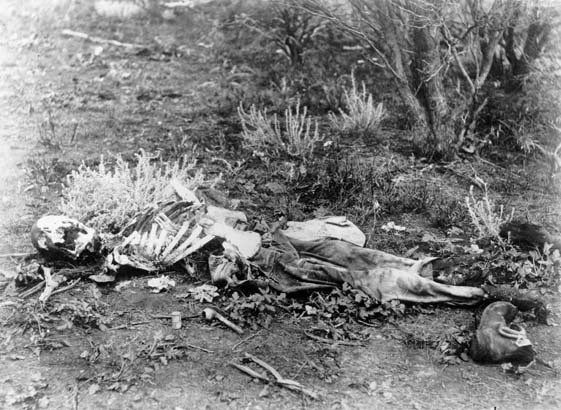|
Minimum Number Of Individuals
In disciplines including forensic anthropology, bioarchaeology, osteoarchaeology and zooarchaeology Minimum number of individuals, or MNI, refers to the fewest possible number of people or animals in a skeletal assemblage. It is used to determine an estimate of how many people or animals are present in a cluster of bones. The principle of the minimum number of individuals was defined by the North American ethnologist T. E. White in 1953. The principle of MNI accounts for each possible individual human or animal as an individual unit in the most parsimonious way, meaning to count ''the lowest number of individuals'' in an archaeological site. While there are formulae that can be applied to determining MNI, it is essentially a logic game. If there were two femurs, a left and a right, then the MNI=1. If there were two left femurs then the MNI=2. If there are three examples of a right humerus, then obviously that implies there were at least three individuals. If those all three ha ... [...More Info...] [...Related Items...] OR: [Wikipedia] [Google] [Baidu] |
Forensic Anthropology
Forensic anthropology is the application of the anatomical science of anthropology and its various subfields, including forensic archaeology and forensic taphonomy, in a legal setting. A forensic anthropologist can assist in the identification of deceased individuals whose remains are decomposed, burned, mutilated or otherwise unrecognizable, as might happen in a plane crash. Forensic anthropologists are also instrumental in the investigation and documentation of genocide and mass graves. Along with forensic pathologists, forensic dentists, and homicide investigators, forensic anthropologists commonly testify in court as expert witnesses. Using physical markers present on a skeleton, a forensic anthropologist can potentially determine a person's age, sex, stature, and race. In addition to identifying physical characteristics of the individual, forensic anthropologists can use skeletal abnormalities to potentially determine cause of death, past trauma such as broken bones or me ... [...More Info...] [...Related Items...] OR: [Wikipedia] [Google] [Baidu] |
Bioarchaeology
The term bioarchaeology has been attributed to British archaeologist Grahame Clark who, in 1972, defined it as the study of animal and human bones from archaeological sites. Redefined in 1977 by Jane Buikstra, bioarchaeology in the United States now refers to the scientific study of human remains from archaeological sites, a discipline known in other countries as osteoarchaeology, osteology or palaeo-osteology. Compared to bioarchaeology, osteoarchaeology is the scientific study that solely focus on the human skeleton. The human skeleton is used to tell us about health, lifestyle, diet, mortality and physique of the past. Furthermore, palaeo-osteology is simple the study of ancient bones. In contrast, the term bioarchaeology is used in Europe to describe the study of all biological remains from archaeological sites. Although Clark used it to describe just human remains and animal remains (zoology/archaeozoology), increasingly modern archaeologists also include botanical remains (bot ... [...More Info...] [...Related Items...] OR: [Wikipedia] [Google] [Baidu] |
Osteoarchaeology
The term bioarchaeology has been attributed to British archaeologist Grahame Clark who, in 1972, defined it as the study of animal and human bones from archaeological sites. Redefined in 1977 by Jane Buikstra, bioarchaeology in the United States now refers to the scientific study of human remains from archaeological sites, a discipline known in other countries as osteoarchaeology, osteology or palaeo-osteology. Compared to bioarchaeology, osteoarchaeology is the scientific study that solely focus on the human skeleton. The human skeleton is used to tell us about health, lifestyle, diet, mortality and physique of the past. Furthermore, palaeo-osteology is simple the study of ancient bones. In contrast, the term bioarchaeology is used in Europe to describe the study of all biological remains from archaeological sites. Although Clark used it to describe just human remains and animal remains (zoology/archaeozoology), increasingly modern archaeologists also include botanical remains (bot ... [...More Info...] [...Related Items...] OR: [Wikipedia] [Google] [Baidu] |
Zooarchaeology
Zooarchaeology (sometimes called archaeozoology), also known as faunal analysis, is a branch of archaeology that studies remains of animals from archaeological sites. Faunal remains are the items left behind when an animal dies. These include bones, shells, hair, chitin, scales, hides, proteins and DNA. Of these items, bones and shells are the ones that occur most frequently at archaeological sites where faunal remains can be found. Most of the time, a majority of these faunal remains do not survive. They often decompose or break because of various circumstances. This can cause difficulties in identifying the remains and interpreting their significance. Zooarchaeology serves as a "hybrid" discipline: combining the studies of archaeology and zoology, which are the study of past human culture and the study of animals respectively. Therefore, zooarchaeologists may also be: anthropologists, paleontologists, archaeologists, zoologists, Ecology, ecologists, etc. However, the main focus ... [...More Info...] [...Related Items...] OR: [Wikipedia] [Google] [Baidu] |
Ethnologist
Ethnology (from the grc-gre, ἔθνος, meaning 'nation') is an academic field that compares and analyzes the characteristics of different peoples and the relationships between them (compare cultural, social, or sociocultural anthropology). Scientific discipline Compared to ethnography, the study of single groups through direct contact with the culture, ethnology takes the research that ethnographers have compiled and then compares and contrasts different cultures. The term ''ethnologia'' (''ethnology'') is credited to Adam Franz Kollár (1718-1783) who used and defined it in his ''Historiae ivrisqve pvblici Regni Vngariae amoenitates'' published in Vienna in 1783. as: “the science of nations and peoples, or, that study of learned men in which they inquire into the origins, languages, customs, and institutions of various nations, and finally into the fatherland and ancient seats, in order to be able better to judge the nations and peoples in their own times.” Koll ... [...More Info...] [...Related Items...] OR: [Wikipedia] [Google] [Baidu] |
Theodore E
Theodore may refer to: Places * Theodore, Alabama, United States * Theodore, Australian Capital Territory * Theodore, Queensland, a town in the Shire of Banana, Australia * Theodore, Saskatchewan, Canada * Theodore Reservoir, a lake in Saskatchewan People * Theodore (given name), includes the etymology of the given name and a list of people * Theodore (surname), a list of people Fictional characters * Theodore "T-Bag" Bagwell, on the television series ''Prison Break'' * Theodore Huxtable, on the television series ''The Cosby Show'' Other uses * Theodore (horse), a British Thoroughbred racehorse * Theodore Racing, a Formula One racing team See also * Principality of Theodoro, a principality in the south-west Crimea from the 13th to 15th centuries * Thoros (other), Armenian for Theodore * James Bass Mullinger James Bass Mullinger (1834 or 1843 – 22 November 1917), sometimes known by his pen name Theodorus, was a British author, historian, lecturer and scholar. A l ... [...More Info...] [...Related Items...] OR: [Wikipedia] [Google] [Baidu] |
Femur
The femur (; ), or thigh bone, is the proximal bone of the hindlimb in tetrapod vertebrates. The head of the femur articulates with the acetabulum in the pelvic bone forming the hip joint, while the distal part of the femur articulates with the tibia (shinbone) and patella (kneecap), forming the knee joint. By most measures the two (left and right) femurs are the strongest bones of the body, and in humans, the largest and thickest. Structure The femur is the only bone in the upper leg. The two femurs converge medially toward the knees, where they articulate with the proximal ends of the tibiae. The angle of convergence of the femora is a major factor in determining the femoral-tibial angle. Human females have thicker pelvic bones, causing their femora to converge more than in males. In the condition ''genu valgum'' (knock knee) the femurs converge so much that the knees touch one another. The opposite extreme is ''genu varum'' (bow-leggedness). In the general populatio ... [...More Info...] [...Related Items...] OR: [Wikipedia] [Google] [Baidu] |
Humerus
The humerus (; ) is a long bone in the arm that runs from the shoulder to the elbow. It connects the scapula and the two bones of the lower arm, the radius and ulna, and consists of three sections. The humeral upper extremity consists of a rounded head, a narrow neck, and two short processes (tubercles, sometimes called tuberosities). The body is cylindrical in its upper portion, and more prismatic below. The lower extremity consists of 2 epicondyles, 2 processes (trochlea & capitulum), and 3 fossae (radial fossa, coronoid fossa, and olecranon fossa). As well as its true anatomical neck, the constriction below the greater and lesser tubercles of the humerus is referred to as its surgical neck due to its tendency to fracture, thus often becoming the focus of surgeons. Etymology The word "humerus" is derived from la, humerus, umerus meaning upper arm, shoulder, and is linguistically related to Gothic ''ams'' shoulder and Greek ''ōmos''. Structure Upper extremity The upper or pr ... [...More Info...] [...Related Items...] OR: [Wikipedia] [Google] [Baidu] |
Skull
The skull is a bone protective cavity for the brain. The skull is composed of four types of bone i.e., cranial bones, facial bones, ear ossicles and hyoid bone. However two parts are more prominent: the cranium and the mandible. In humans, these two parts are the neurocranium and the viscerocranium ( facial skeleton) that includes the mandible as its largest bone. The skull forms the anterior-most portion of the skeleton and is a product of cephalisation—housing the brain, and several sensory structures such as the eyes, ears, nose, and mouth. In humans these sensory structures are part of the facial skeleton. Functions of the skull include protection of the brain, fixing the distance between the eyes to allow stereoscopic vision, and fixing the position of the ears to enable sound localisation of the direction and distance of sounds. In some animals, such as horned ungulates (mammals with hooves), the skull also has a defensive function by providing the mount (on the front ... [...More Info...] [...Related Items...] OR: [Wikipedia] [Google] [Baidu] |
Mass Grave
A mass grave is a grave containing multiple human corpses, which may or may not be identified prior to burial. The United Nations has defined a criminal mass grave as a burial site containing three or more victims of execution, although an exact definition is not unanimously agreed upon. Mass graves are usually created after many people die or are killed, and there is a desire to bury the corpses quickly for sanitation concerns. Although mass graves can be used during major conflicts such as war and crime, in modern times they may be used after a famine, epidemic, or natural disaster. In disasters, mass graves are used for infection and disease control. In such cases, there is often a breakdown of the social infrastructure that would enable proper identification and disposal of individual bodies. History Mass or communal burial was a common practice before the development of a dependable crematory chamber by Ludovico Brunetti in 1873. In ancient Rome waste and dead bodies of the ... [...More Info...] [...Related Items...] OR: [Wikipedia] [Google] [Baidu] |
Osteology
Osteology () is the scientific study of bones, practised by osteologists. A subdiscipline of anatomy, anthropology, and paleontology, osteology is the detailed study of the structure of bones, skeletal elements, teeth, microbone morphology, function, disease, pathology, the process of ossification (from cartilaginous molds), and the resistance and hardness of bones (biophysics). Osteologists frequently work in the public and private sector as consultants for museums, scientists for research laboratories, scientists for medical investigations and/or for companies producing osteological reproductions in an academic context. Osteology and osteologists should not be confused with the pseudoscientific practice of osteopathy and its practitioners, osteopaths. Methods A typical analysis will include: * an inventory of the skeletal elements present * a dental inventory * aging data, based upon epiphyseal fusion and dental eruption (for subadults) and deterioration of the pubic symp ... [...More Info...] [...Related Items...] OR: [Wikipedia] [Google] [Baidu] |








